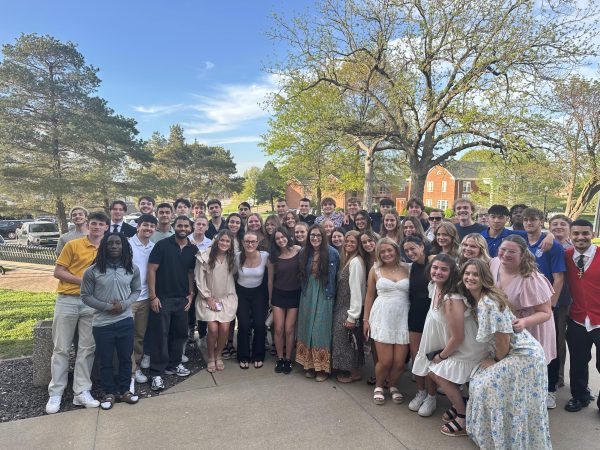Ukraine Conflict Joined by Ethiopia, Yemen in latest International Series Installment
On Thursday, March 31, Drs. DeWaard and Hotle hosted another installment of the International Series, making a “game day change” which invited the unique perspectives of Major Michael Stedman, an expert in counterinsurgency from the U.S. Army as well as one of the campus’ own students of Ethiopian descent, who asked not to be named due to family sensitivities surrounding the ongoing conflict. The event follows on the heels of a series hosted throughout the semester, covering the situation in Ukraine before moving on to detail the conflicts in Yemen and Ethiopia, detailing the complex, multi-layered conflicts raging across both nations. Another event is planned to take place sometime in the three-week portion of the semester.
Ukraine
The mention of Ukraine was rather brief, noting that the lines of battle hadn’t shifted much since the last event, especially compared to international expectations, as Russia vastly underperformed, and Ukraine overperformed in military engagements. The long sieges that have come to characterize the war have created many humanitarian crises, most prominently the mass displacement of civilians. Ten million Ukrainians, or up to a quarter of the nation’s population, were displaced at the time of speaking. While many remained in the country, a significant portion, primarily women and children, had fled as refugees into neighboring NATO nations such as Poland, which had accepted several million people on its own.
Speaking on Zoom following the introduction, Major Stedman affirmed that he had been cleared to speak from his personal experience, giving comments as an individual and not a representative of the Army. Relating his position as an Army Intelligence Officer who had served three tours in the Middle East, one in Iraq and two in Afghanistan. Major Stedman laid out the basic issues of counterinsurgency as faced in the region. His primary concern was shifting rules of engagement, which were tightened toward the end of the war, establishing a standard where troops could only fire when fired upon, and holding a clear certainty of the position of the attacker. Outside the wires of the United State’s bases, he recalled being on pins and needles, concerned that the ununiformed enemy could be among any of those locals pleading for his unit’s aid. One of the most concerning episodes of such, he recalled, was the detonation of an I.E.D. (improvised explosive device) inside a hospital, where American troops were attempting to administer life-saving aid to the locals. He recalled that it was hard to reconcile the danger of such incidents, and the need to provide aid to the desperate civilians in the area. The other major factor was the risk of “blue-on-green” attacks, or ostensibly friendly Iraqi forces turning on the soldiers of the U.S. and its allies, the local police, or the local military. These are well-known issues, spoken of at length in a prior article published on Hotle and DeWaard’s Afghanistan series, which offered something of a postmortem following the United States’ withdrawal from the nation.
Major Stedman was offered a few questions from the presenters and students as to what might prompt involvement or escalation in international conflicts on part of the U.S., or what future interventions might be considered, as well as what developments could be expected in Ukraine. However, he politely but firmly closed the matter, stating that he was not authorized to speak on such topics. He was able to offer some thoughts, comparing the devastation seen in Ukranian cities like Mariupol with those of Iraq and Afghanistan. Musing on the overall outcomes of the missions, Major Stedman recalled his time in Helman and Jalalabad, briefing the head of special operations on intelligence. He found the U.S. retreat to give a crushing feeling, having lost many good friends, only able to offer his sincere hope that one day, Afghanistan and Iraq might again see democratic governance, and push off the influence of actors like ISIS or Iran. Amusingly, when asked about the Russians’ underperformance in Ukraine, he noted that he’d used some of the leftover equipment from the Russian invasion during his time in Afghanistan, and found it, simply, “not good.”
With one student having inquired what lessons on counterinsurgency the U.S. took out of Vietnam, and apply to these more modern conflicts, Major Stedman stated that, as a student of political science and fan of history, he was aware there were always lessons to be taken from past, such as how to treat locals. For instance, a lot of local nationals in Iraq embedded in villages, saved U.S. forces time and time again, giving up weapons caches, and revealing the locations of insurgents. Noting it as cliche but useful, he cited General Petraeus’ stance on the strategy of hearts and minds, noting, “If a population knows you’re there for them, and you’re not blowing smoke, they’ll go out of their way for you. Help you help them.”
Ethiopia
Opening with a bit of context offered by Dr. Hotle, he had remarked that the U.S. is often remarkably poor in discussing conflicts such as those in Yemen and Ethiopia. Hotle mentioned, “there’s something in that, we don’t learn these things without involvement, war.” He detailed that Ethiopia is one of the most prominent African nations, notably never colonized, and home to the birthplace of Aksum and a number of other remarkable ancient civilizations, many of which had their start in the region of Tigray, these antiquities now threatened by modern conflict. And, that’s not even to start on the mass casualties, the man-made famine, and brutalization that has typified the current conflict. A region famous for being one of the earliest converts to Christianity, and a sanctuary for the Prophet Muhammad during turbulent times.
A student from Culver-Stockton, of half-Tigrayan, half Amhara descent opened the discussion on Ethiopia’s ongoing civil war, from a uniquely insightful perspective. From a family deeply divided over the issue, the student didn’t feel comfortable having their name included in this story, noting that they had spoken on a deeply divisive, personal issue despite the taboo of the topic. Ethiopia is a nation of many ethnicities, divided primarily between Coptic and Protestant Christianity and Sunni Islam, held in a federal system loose enough where the regions, based on language and ethnicity, and functioning like states in the U.S., possess their own remarkably independent militaries. The current conflict, in Ethiopia, as they laid it out had been set up in the 1980s, in an ancient nation divided across many ethnic and political lines. Ethiopia’s federal government had attempted to round up and kill members of minority groups, prompting the region of Eritrea to rise up and seize power from the federal government of Ethiopia.
With a war lasting to 1993, many of the nation’s people, as well as his own family were displaced, first to Sudan, then many on to the United States, where they were born. The Tigrayans were successful in taking power, holding it to the 2018 elections. However, the conflict merely simmered until the 2020 elections, which the federal government called off due to the pandemic, all regions save for Tigray canceling their elections for the sake of public safety. Seeking goodwill and forgiveness for the murders and other crimes committed during their time in power, the Tigrayan People’s Liberation Front pushed ahead in holding elections, prompting the federal government to cut funding to the region. In retaliation, the TPLF’s forces staged an attack on a northern outpost of federal troops near the border of Eritrea, a region that had voted to break away from the remainder of the nation some decades prior, leading to a longstanding rivalry. Federal troops not of Tigrayan descent present at the outpost were killed in their sleep
Ethiopia and Eritrea, with recently warming relations, found sudden solidarity in the opportunity to work together against the TPLF, attacking largely on ethnic lines, and prompting many Tigrayans, who resented the TPLF after their long stand in power to wonder why the federal government, after being given their support, had abandoned them. The war quickly turned nasty, with children pulled from schools to serve as soldiers, as the TPLF, used a stockpile of arms acquired during their many years as the dominant power within Ethiopia to defy a potential ceasefire and push within 126 miles of the nation’s capital, meaning to take control, as had been done before. However, acceding to a ceasefire at this position, the federal government was empowered to negotiate with Turkey and the United Arab Emirates for the acquisition of drones and other arms. The federal government claimed that the TPLF had unlawfully seized land from the Amhara region, causing intense conflict between Amhara and Tigray.
With parents descended from both regions, the speaker noted that their family had been caught up in the fighting, making it impossible to discuss in a civil manner as their relatives split down the sides of the conflict, with lives lost, and even their partner’s family, also from Ethiopia, touched by the brutal conflict. Peace talks seem hopeless, with only the talk of humanitarian corridors for aid being indulged, considerations to allow food through, and forestall a manmade famine in landlocked Tigray which resulted from the war. The speaker noted that Ethiopia, as the sole power of Africa never to be colonized, stands full of prideful people who aren’t so eager to resolve the conflict at hand.
They laid out the senseless horror of Ethiopia’s civil war with a simple comparison, noting that, despite how bad they may seem, the U.S.’ political divisions hardly compare to that of Ethiopia. Given the example of the U.S. attacking Washington State, they’d fight back. But, they stated, that nothing in America can compare to the struggles in Ethiopia. The divisions in politics here seem like nothing compared to African politics, even after 2020 reminded us that we can’t take what we have for granted. On-campus, we can go out into the hallway to fill our water, and out to the Caf to get food, but in Ethiopia, many people lack the basic necessities of food and water.
Yemen
Hotle opened his remarks on Yemen, noting that the region lies straight across the Red Sea from Ethiopia, at the southeastern end of the Arabian Peninsula. Unlike most of the oil-dependent petrostates in the region, Yemen is noted for being a comparably green haven in the famously desolate peninsula. In addition to other challenges, the region’s conflict is defined by the split between Sunni and Shi’a Islam, two sects of the religion whose divide loosely might be compared to that of Catholic and Orthodox Christianity. In short, Sunni Muslims follow the doctrine that any just person can read and interpret the region’s holy text, the Quran, whereas the Shi’a remain loyal to the idea that the blood descendants of the Prophet Muhammad are best suited to lead the faith, a divide stemming from power struggles in the time of the original Muslim Caliphate of the seventh century. Sunni Islam is most prominently represented by Saudi Arabia, which holds the religion’s holiest cities of Mecca and Medina, while Iran, a rival power in the region stands as the most prominent representative of Shi’a Islam. Both nations have been known to sponsor insurgent groups following their doctrine across the region, from the U.S.’s more familiar adversaries such as Al Queda or the Taliban, whose funding has been closely linked to Saudi Arabia, or Iran-backed groups like the Houthi militias in Yemen, or Hezbollah in Lebanon.
The fighting in Yemen is defined primarily by a Saudi-backed government’s opposition to Iranian-backed Houthi rebels, defined by air campaigns by the well-equipped Saudis, who benefit from generous arrangements for the provision of arms by the United States to counter Iran’s influence. This strategy has led to extensive casualties among civilian populations, and disasters such as famine ravaging the war-torn nation. The conflict in Yemen is remarkably complex, with interference from neighboring powers such as the United Arab Emirates, another Sunni nation, and other factions such as Al-Queda holding substantial territory in the region. Both the Saudis and UAE are also notable sponsors of the federal government of Ethiopia.
Furthermore, for those interested in watching the developments of these conflicts, reliable news sources such as the British Broadcasting Company (BBC) and The Council on Foreign Relations (CFR) have excellent programming to stay informed on world events, such as the CFR’s extensive library of video and podcasts, while PBS’ Frontline has recently released a documentary on the rise of Russian President Vladimir Putin which helps to provide an individual-level analysis of one of the world’s most relevant and concerning leaders.











